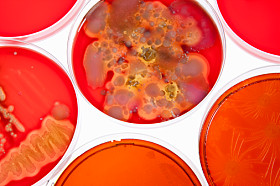 A survey conducted by the AABB Bacterial Contamination Task Force has found variation across member institutions in the methods used for the detection of bacteria in platelet products. Among the 224 blood centers, hospital blood banks, and transfusion services surveyed, 64 institutions manufactured platelets, producing more than 1.7 million apheresis platelets (APs). APs were most frequently screened using the BacT/ALERT system (89.5%) or the eBDS system (10.4%), with 95.2% of APs cultured in at least 8mL of product. However, there was substantial variability in incubation time between inoculation and release ofplatelets during culture-based testing. Surveydata also suggested that since the AABB Standard 5.1.5.1.1 was instated to establishminimum assay sensitivity requirements and regulate methods used for bacterial detection,member institutions had decreased production of whole blood-derived plateletconcentrates (WBPCs). Among institutionswhich had transfused WBPCs prior to the standard becoming effective, 14.3%decreased use and 53.1% stopped use entirely. Further studies are needed to optimize bacterial screening policy.
A survey conducted by the AABB Bacterial Contamination Task Force has found variation across member institutions in the methods used for the detection of bacteria in platelet products. Among the 224 blood centers, hospital blood banks, and transfusion services surveyed, 64 institutions manufactured platelets, producing more than 1.7 million apheresis platelets (APs). APs were most frequently screened using the BacT/ALERT system (89.5%) or the eBDS system (10.4%), with 95.2% of APs cultured in at least 8mL of product. However, there was substantial variability in incubation time between inoculation and release ofplatelets during culture-based testing. Surveydata also suggested that since the AABB Standard 5.1.5.1.1 was instated to establishminimum assay sensitivity requirements and regulate methods used for bacterial detection,member institutions had decreased production of whole blood-derived plateletconcentrates (WBPCs). Among institutionswhich had transfused WBPCs prior to the standard becoming effective, 14.3%decreased use and 53.1% stopped use entirely. Further studies are needed to optimize bacterial screening policy.
Reference
